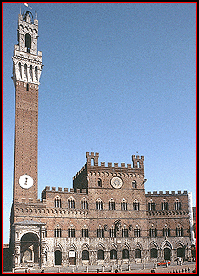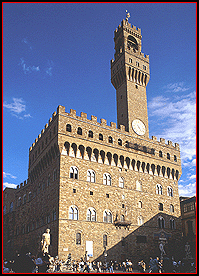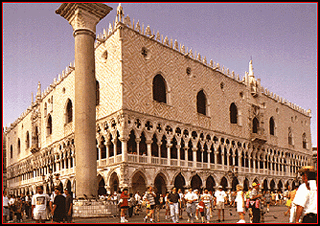Civic Architecture
BACKGROUND TO CIVIC PALACES
Function and Importance in Medieval Italy
The shift in power from feudal landlords to representatives of the comuni in medieval Italy increased the need for civic palaces so that governing bodies would have a place to meet. Civic palaces were first built in the thirteenth century. Prior to this, churches were generally used as civic meeting places.
Because many local constitutions provided that governors be chosen from outside the comune, many civic palaces included residential quarters to accommodate them.
Emblematic Quality
Like cathedrals, civic palaces were regarded with pride by the city's residents. Their towers, whose height was a special point of communal pride, were often the highest and most distinct features of the local skyline.
Names
Medieval civic palaces in Italy were known by a variety of names depending on the form of government under which they were established. Common names are Palazzo del Comune, Palazzo Pubblico (People), Palazzo della Signoria (Governing Council), Palazzo dei Priori (Priors), Palazzo del Podestà (Magistrate), and Palazzo della Ragione (Justice).
Some civic palaces have carried a sequence of names in accordance with changes in local government. The Palazzo Vecchio in Florence, for instance, was known by five names: Palazzo dei Priori, Palazzo del Popolo, Palazzo della Signoria, Palazzo Ducale (duke), and Palazzo Vecchio (old).
DESIGN OF CIVIC PALACES
Exterior Materials
Brick was the most common material for the exterior.
The use of stone depended on its availability regionally. It was commonly used for the trim of brick buildings. Stone also covered entire structures as rusticated masonry or, in places where there was political stability, as encrusted patterns.
Two Types of Civic Palaces
There were two basic types of civic palace, and their forms corresponded to the local conditions. In places where there was political stability, a more open structure incorporating a loggia was generally adopted. Fortifications were generally absent. In places where there was political turbulence such as Tuscany, a closed, fortified structure was used.
Unfortified civic palaces with open features were more common in northern Italy, and fortified civic palaces with closed exteriors were more common in central Italy.
Both types of civic palaces had blockish cores. In style, they followed architectural trends in their regions.
Unfortified Civic Palaces
A popular form of civic palace in Northern Italy consisted of an open loggia on the ground story and meeting halls on the story above. Over time, arches were often filled in.
For larger buildings, loggias sometimes stood along one or more sides of the ground story and supported the outer rooms of the upper stories.
Other open features that were commonly used on unfortified civic palaces are external staircases and balconies.
Fortified Civic Palaces
Defensive features were important in many regions both because of the threat of invasion from neighbors or foreign powers and because of political instability at the local level. Local conflicts arose from warfare between opposing political factions, competition for power among rich families, and uprisings from citizens who were dissatisfied with the government.
A closed form of civic palace, of which the Palazzo Bargello is an early example, was designed for defense.
Trims such as stringcourses were often plain, and stone was left undressed. The lack of ornamentation and use of rough texture gave fortified civic palaces a look of impregnability that was intended to discourage attackers.
Courtyards, which were generally located in the center of the building, accommodated a variety of activities involving groups of citizens or members of the government.
Defensive Features of Fortified Palaces
Several types of defensive features were used in building fortified civic palaces, which were derived from medieval castles. The term "castellated," which is rooted in "castle," refers to the presence of defensive features like crenellations and machicolations and other features aimed at defending against medieval siege engines. Not present on these buildings are features that would have compromised the palace's defensive capacity like loggias or external staircases.
●Tall, strategically located towers. Towers were especially important for fortified civic palaces. Their great height boasted of the power of the communal government and provided advantageous views of the surrounding city, allowing watchers to spot invading armies or groups of rebels. The number of viewing angles was sometimes increased by making the tops of towers polygonal. Towers were frequently located over vulnerable parts of the palace like entrances or corners. Alignment with approaching streets also enhanced their utility as look-out points. Bells, which were large enough to be heard throughout the city, called men to arms or warned the populace of impending danger.
●High walls. High walls were intended to prevent the enemy from gaining entrance through the roof.
●Crenellations. Crenellations, which are also called battlements, allowed soldiers to take cover while fighting.
●Machicolations. Machicolations provided an overhang from which enemies who attempted to scale the walls or ram the door could be attacked from above.
●Small windows. To minimize the enemy's chances of gaining access through them, windows, especially those close to the ground level, were small in size.
●Wells. A well within the courtyard enabled occupants to obtain water in time of siege.
EXAMPLES OF CIVIC PALACES
Civic Palaces in Northern Italy
♦ Broletto, Como
♦ Broletto, Monza
♦ Palazzo Ducale (Doge's Palace), Venice
♦ Palazzo della Ragione, Verona
Civic Palaces in Central Italy
♦ Palazzo Bargello (originally the Palazzo del Podestà), Florence
♦ Palazzo Vecchio (originally the Palazzo del Priori), Florence
♦ Palazzo dei Priori, Volterra
CIVIC LOGGIAS
Functions
Independent loggias were especially useful for open-air markets and meeting places.
They were sometimes located near but separate from fortified civic palaces, whose defensive capacity would have been compromised if they had been attached.
Examples
Two important civic loggias were built in Florence in the fourteenth century.
♦Orsanmichele. Orsanmichele, which was originally a grain market, was Florence's first civic loggia.
♦Loggia dei Lanzi. The Loggia dei Lanzi, which stands near Florence's civic palace, provided a sheltered place for ceremonies and announcements that formerly took place on a platform at the latter's entrance. The old platform then provided a convenient place from which to watch activities in the loggia.
CIVIC PIAZZAS
Definition
Piazzas were open expanses, usually paved, that were enclosed by a city's urban fabric of buildings and streets.
Connection with Marketplace Activity
Piazzas evolved from medieval public markets where food and goods were sold. The economic boom and subsequent growth of the population that began in the twelfth century increased the need for spaces to accommodate markets and communal events. Public markets were often located just outside or just inside city gates, where there was much traffic. They were also situated to the side or rear of churches.
Some piazzas still function as marketplaces on weekends.
Grouping Ecclesiastic and Civic Buildings
Ecclesiastic and civic buildings were sometimes clustered around a common piazza or series of piazzas, which increased the space's utility because it could be used for both civic and ecclesiastic activities. In Perugia, for instance, the cathedral and the civic palace stood across from each other on a common piazza.
In Venice, where San Marco and the Doge's Palace (Venice's civic palace) stand next to each other, a single campanile serves both.
Size and Shape
The shapes of piazzas were often irregular because they were defined by existing streets and buildings.
Irregularity of Surrounding Buildings
The buildings surrounding piazzas generally varied in height and style. The aesthetic problem this posed was addressed in Siena in the thirteenth century when the piazza in front of the Palazzo Pubblico was built. The Sienese government recommended that buildings surrounding the piazza be similar in height and window style.
Important Civic Piazzas
The piazzas in front of civic palaces are each distinct in size and shape.
♦Piazza della Signoria, Florence. The irregular, L-shape of Florence's Piazza della Signoria reflects the Palazzo Vecchio's entrance having originally occupied its left side. The original site, which was later expanded as additional land became available, had been seized from a family who had been banished for treason, and the building of a piazza was intended to dissuade that family from attempting to return.
♦Piazzas of Perugia. Several piazzas surround the Church of San Lorenzo in Perugia, which stands near the city's civic palace, the Palazzo dei Priori.
♦Piazza del Campo, Siena. Siena's famous shell-shaped piazza was ahead of its time in having a nearly symmetrical shape and an enframement of buildings that were stylistically similar due to municipal regulations.
♦Piazza San Marco and Piazzetta San Marco, Venice. Venice's Cathedral and civic palace stand adjacent to each other at the junction of two piazzas, the Piazza San Marco and the Piazzetta San Marco.
♦Piazza of the Fontana Grande, Viterbo. The main civic piazza of Viterbo is dominated the a large fountain, the Fontana Grande (1206-79), which stands near the Palazzo del Podestà (1247).



 Add Placemark
Add Placemark Go Back
Go Back 







